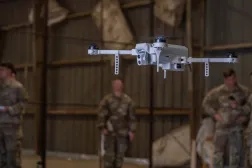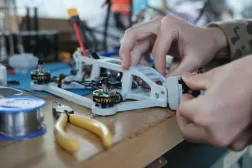Armored formation kicks off second round of transforming-in-contact with Pegasus Charge

1st Cavalry Division is helping the Army determine what the future of armored formations will look like.
1st Brigade, 1st Cavalry Division, or Iron Horse, has been designated as one of the next so-called “transforming-in-contact” brigades, a top initiative for Chief of Staff Gen. Randy George. The effort aims to speed up how the Army buys capabilities and designs its forces by injecting emerging capabilities into units and letting them experiment with them during exercises and deployments.
The first iteration, TiC 1.0, featured light infantry units and saw them transition to either mobile or light brigades. TiC 2.0 now is turning its attention to armored formations — which have typically been left out given integrating capabilities on their platforms is difficult — along with divisions as a whole to include enabling units such as artillery and air cavalry brigades.
1st Cav’s experimentation efforts will be nestled under what it calls Pegasus Charge, which kicked off last week.
“Everything that we’re going to do across the transformation-in-contact effort lines will be under Pegasus Charge,” Maj. Gen. Thomas Feltey, commander of 1st Cavalry Division, said in an interview. “We’re not just looking at it from a purely organizational and material solution, whereas that’s part of it, [but] we’re looking at it more comprehensively across the” doctrine, organization, training, materiel, leadership and education, personnel, facilities and policy aspects.
Pegasus Charge started with a deep dive on what an armored brigade should look like in the future.
That will evolve as the unit receives new gear and gets to test it, but that transformation is pivotal to the TiC effort.
Unlike the lighter units, which have been evolving for many years, Feltey noted that armored units have been relatively unchanged since the early 2000s.
“We’re developing options for battalions, for our armored cavalry squadron. We’re going to change the way our cavalry fights and then we’re also going to change the way that our brigades fight with the divisions,’ he said.
As the Army moves from the brigade as the main fighting unit to division, Feltey noted that brigades will need to rely more on division assets. His division through TiC is seeking to inform what that will look like in the future.
1st Cavalry Division headquarters recently came back from Europe, where it served as the higher echelon over the last TiC 1.0 unit, 3rd Brigade, 10th Mountain Division.
Feltey said he learned a lot of lessons as that unit tested new capabilities — namely, that his units will need longer-range drones. While 3rd Brigade, 10th Mountain Division had the Short Range Reconnaissance unmanned aerial system, Feltey said his units will need the Medium Range Reconnaissance UAS and Long Range Reconnaissance UAS.
“We’re more interested in the MRR that can see beyond line of sight and beyond the direct fire range of our tanks and our Bradleys,” he said.
Similarly, Feltey also noted that 3rd Brigade, 10th Mountain was able to see farther than it could deliver effects on the battlefield, he said. In other words, the brigade did not possess the capabilities to strike some of the targets it saw with either direct or indirect fires. A main reason for that was the towed artillery platforms that unit had.
By contrast, 1st Brigade, 1st Cavalry Division will be getting the upgraded Paladin M109A7 artillery system, which can mass fires more quickly than the towed artillery 3rd Brigade had.
This was an observation that 1st Cav is trying to get ahead of as it begins its TiC journey.
“We can shoot and move, shoot and move. We’ll have be able to have an increased volume of fire. And that increased volume of fire will allow us to suppress and deliver fires more effectively across the brigades’ area of operations. When we see something in our brigades, we’re going to be able to hit them. We’re going to be able to strike them,” Feltey said. “Then systematically, our forward observers, like our artillery, should have MRR or LRR UASs. They’re the contemporary forward observers, so our artillery can be out there, hunting both key enemy weapon systems, but also identifying those important places where we need to deliver suppressive effects to let our forces move forward. Again, organizationally, this will be something we look at DIVARTY, how do we shorten that kill chain to get those effective fires, massing those fires in the time and place that we need them to advance our forces on the battlefield?”
On the communications front, Feltey noted his units are likely slated to get upgraded network gear as well, to include Starshield, MUOS, and technologies associated with the integrated tactical network. The Army’s network portfolio has largely focused on light infantry units given the ease of integration. It is now beginning to turn its attention to the heavier units to enable them to perform functions on the move as opposed to at the halt, a critical enabler in future warfare as units can’t afford to stop for long periods of time.
In fact, the Army tested its prototype for Next Generation Command and Control with an armored unit at Project Convergence in March in order to start with the most difficult type of unit.
Getting new kit
1st Brigade will also be receiving new equipment in the way of the latest and greatest Army capabilities. Those include the aforementioned upgraded Paladin M109A7 artillery system, M2A4 Bradley Fighting Vehicle, Armored Multi-Purpose Vehicle and the Low Altitude Stalking and Strike Ordnance.
Along with that new equipment, the unit will also seek to reorganize similar to how the first TiC units created new company units designed to make them more lethal by combining drones, loitering munitions, mortars and other equipment to shorten the sensor-to-shooter chain.
However, unlike those units, 1st Cav already had brigade cavalry squadrons for reconnaissance whereas the lighter units had to create those formations.
The armored units will seek to enhance the cavalry squadron’s ability to conduct reconnaissance through technical means by looking to integrate human-machine interface platoons such as autonomous robots, sensors and UAS.
“Organizationally, we’re trying to figure out what’s the best way to harness those formations to give us increased lethality — or not only increased lethality, but also increased understanding of the battlefield that allows the commander to make decisions, whether those are decisions to kill the enemy or decisions to move the enemy in a place where the enemy doesn’t expect it,” Feltey said.
1st Cav’s timeline for when its activities will take place will be slightly longer than the units in the first iteration of transforming-in-contact.
The culminating combat training center rotation for 1st Brigade, the most realistic combat scenarios the Army can create for units to train, won’t be until 2027. However, there are several other events before then. Small unit fielding and training of new systems will occur by the turn of calendar year 2026.
The big step between now and the combat training center rotation will be a warfighter exercise next summer. Unlike some events that are mostly tabletop or command post exercises, this one will be a blend of live and constructive training, which Feltey called a “dirt fighter.”






